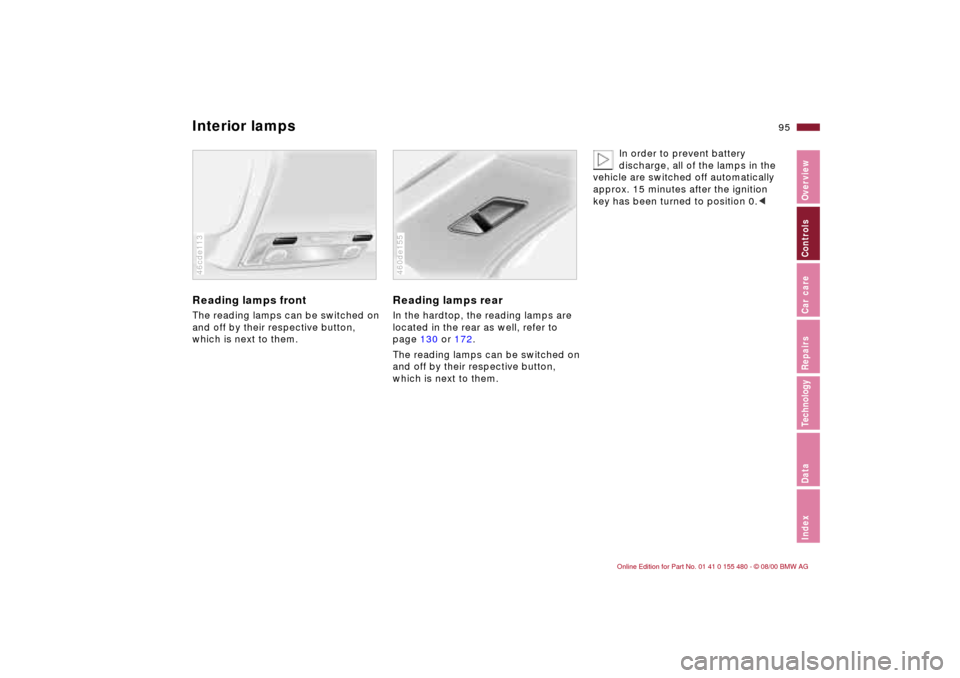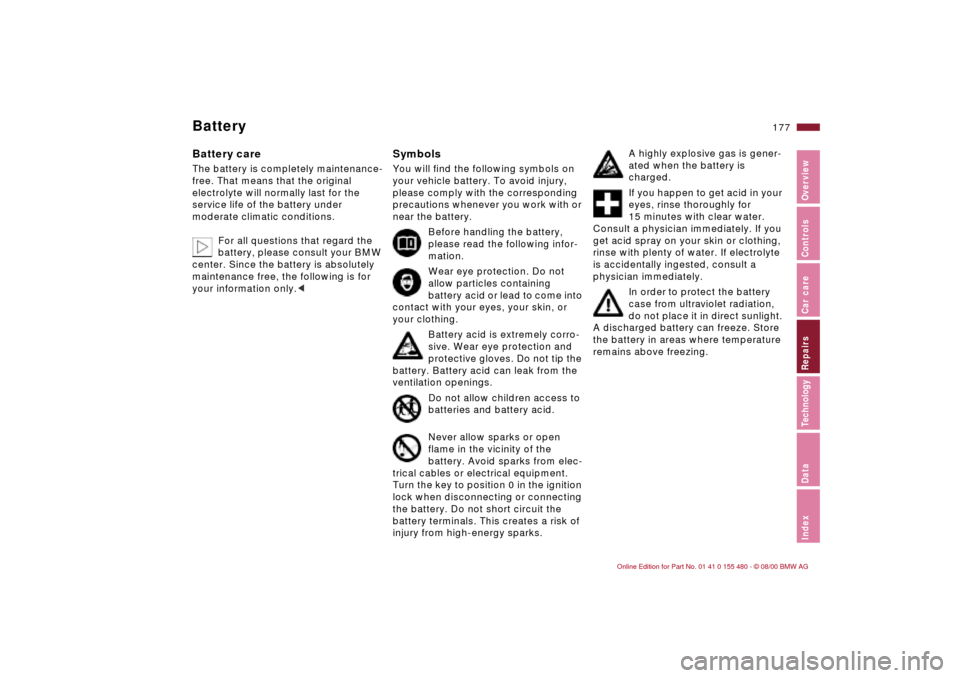2001 BMW 330Ci CONVERTIBLE key battery
[x] Cancel search: key batteryPage 20 of 215

20n
Indicator and warning lamps
Technology that monitors itself
Many of the systems of your BMW
monitor themselves automatically, both
during engine starts and while you are
driving. Indicator and warning lamps
that are identified by "
l
" are tested for
proper functioning whenever the igni-
tion key is turned. They each light up
once for different periods of time.
If a fault should occur in one of these
systems, the corresponding lamp does
not go out after the engine is started, or
it lights up while the vehicle is moving.
You will see how to react to this below.
Red: stop immediately
Battery charge
l
The battery is no longer being
charged. There is a malfunction
of the alternator V-belt or in the
charging circuit of the alternator. Please
contact the nearest BMW center.
If the V-belt is defective, do not
continue driving, otherwise, the
engine could be damaged due to over-
heating. If the V-belt is defective,
increased steering effort is also
required.
<
Engine oil pressure
l
Stop the vehicle immediately
and switch off the engine.
Check the engine oil and top off as
required. If the oil level is correct,
please contact the nearest BMW
center.
Do not continue driving. If you do
so, the engine could be damaged
because of inadequate lubrication.
<
Tire Pressure Control (RDC) l
In addition, an acoustic signal is
sounded: a tire failure has
occurred. Reduce vehicle speed imme-
diately to stop the vehicle. Avoid hard
brake applications. Do not oversteer.
For additional information, refer to
page 91.
Brake warning lamp l
If the lamp comes on when the
parking brake is not engaged:
check the brake fluid level. Before
driving further, be sure to read the
notes on pages 126 and 148.
Brake warning lamp for Cana-
dian models.
Page 32 of 215

32n
Keys1 The remote control master keys
determine Key Memory functions.
Refer to page 59
There is an extended-life battery
in every master key that is
charged automatically in the ignition
lock as you drive.
At least once a year, drive for an
extended period with a master key that
you do not use otherwise to charge the
battery. Refer also to page 35.<
2 Spare key for storage in a safe place,
such as in your wallet. This key is not
intended for constant use 46cde059
3 Door and ignition key
The locks for the luggage compart-
ment lid and the glove compartment
cannot be operated with this key Ð
this is recommended for valet
parking, for instance
Replacement keysReplacement keys are available exclu-
sively through your BMW center.
Checking vehicle ownership is manda-
tory, since the keys are part of a secu-
rity system. (Refer to "Electronic vehicle
immobilizer" on page 33).
If possible, take all of the master
keys that belong to the vehicle
with you when you pick up your
replacement key.
Whenever you receive a new replace-
ment key, turn that key to position 2 in
the ignition lock once (ignition switched
on) and then back. This allows the elec-
tronic vehicle immobilizer to "learn" the
new key.<
Page 35 of 215

35n
IndexDataTechnologyRepairsCar careControlsOverview
Opening and closing Ð from the outsideUsing the remote control The remote control gives you an excep-
tionally convenient method for
unlocking and locking your vehicle.
Furthermore, it provides two additional
functions that can only be executed by
means of the remote control:
>Switch on the interior lamps, refer to
page 36.
With this function, you can also
"search for" your vehicle Ñ when
parked in an underground garage for
instance.
>To open the luggage compartment,
refer to page 36
The luggage compartment lid will
open slightly, regardless of whether it
was locked or unlocked.
The anti-theft system is also deacti-
vated simultaneously when you unlock
the vehicle, the alarm system is
disarmed, and the interior lamps are
turned on. When you lock the vehicle,
the systems are activated and armed,
and the lamps go off.
You can have a signal set as an
acknowledgment message that
the vehicle is closed correctly.<
Master keysKeys with remote control are master
keys. Refer to page 32.
Children might be able to lock the
doors from the inside. For this
reason, always take the vehicle keys
with you so that the vehicle can be
opened again from the outside at any
time.<46cde020
Master keys that are used repeat-
edly are always ready for opera-
tion since the battery in the key is
charged automatically in the ignition
lock as you drive.
If it is no longer possible to unlock the
vehicle using the remote control, the
battery is discharged. Use this key
while driving for an extended period in
order to recharge the battery. Refer
also to page 32.
To prevent unauthorized use of the
remote control, surrender only the door
and ignition key or the spare key (refer
to page 32) e. g. whenever leaving the
vehicle for valet parking.
In the event of a system malfunction,
please contact your BMW center. You
can also obtain replacement keys
there.<
Page 42 of 215

42n
Alarm system
*
The conceptThe vehicle alarm system responds:
>When a door, the hood or the
luggage compartment lid is opened.
>To movement inside the vehicle
(interior motion sensor).
>To a change of the vehicle's tilt Ð if
someone attempts to steal the
wheels or tow the vehicle without
authorization, for example.
>If there is an interruption in battery
voltage.
The system responds to unauthorized
vehicle entry and attempted theft by
simultaneously activating the following:
>Sounding an alarm for 30 seconds.
>The hazard warning flashers are acti-
vated for approx. five minutes.
>The high beams flash on and off in the
same rhythm.
To activate and deactivate the
alarm systemWhen the vehicle is locked or unlocked
by using a key or with the remote
control, the alarm system is also simul-
taneously armed or disarmed.
The interior motion sensor and the tilt
alarm sensor are activated approx.
30 seconds after you have finished
locking the vehicle.
If the alarm system has been armed
correctly, the hazard warning flashers
flash once.
You can have a signal set as
acknowledgment for both arming
and disarming the alarm system.<
You can also open the luggage
compartment lid when the system is
armed by pressing button 3 of the
remote control (refer to page 36). When
it is closed, the lid is once again
secured.
Indicator lamp displaysThe indicator lamp is located under the
interior rearview mirror.
>The indicator lamp flashes continu-
ously: the system is armed.
>The indicator lamp flashes while the
system is being armed: the door(s),
the hood or luggage compartment lid
are not completely closed. Even if
you do not close the alerted area(s),
the remaining areas are secure, and
the indicator lamp will flash continu-
ously after 10 seconds. However, the
interior motion sensor is not acti-
vated.
>The indicator lamp goes out when the
system is disarmed: no manipulation
or attempted intrusions have been
detected in the period since the
system was armed.46cus033
Page 70 of 215

70n
Starting the engine Switching off the engine Do not press the accelerator pedal
while starting the engine.
Do not actuate the starter for too
short a time, but do not actuate it
for more than approx. 20 seconds.
Release the ignition key immediately
when the engine starts.
Do not allow the engine to warm up by
leaving it running while the vehicle
remains stationary. Instead, begin
driving immediately at a moderate
engine speed.<
If the engine does not start on the first
attempt (if it is very hot or cold, for
instance):
>Press the accelerator pedal halfway
down while engaging the starter.
Cold starts at very low temperatures,
starting at about +57 (Ð156) and
at high altitudes over 3,300 ft
(1,000 meters):
>On the first start attempt, engage the
starter for a longer period (approx.
10 seconds).
>Press the accelerator pedal halfway
down while engaging the starter.
Engine idle speed is controlled by the
engine computer system. Increased
speeds at start-up are normal and
should decrease as the engine warms
up. If engine speed does not decrease,
service is required.
To prevent the battery from
discharging, always deactivate elec-
trical devices that are not in use. Switch
the ignition off when the vehicle is not
being driven.Turn the ignition key to position 1 or 0.
Do not remove the ignition key
while the vehicle is still moving.
If you did so, the steering lock would
engage when the steering wheel is
turned.
Whenever you leave the vehicle, always
remove the ignition key and lock the
steering wheel.
Vehicles with manual transmission:
Always apply the parking brake
when parking on slopes and inclined
surfaces, since placing the shift lever
in 1st gear or reverse may not provide
adequate resistance to rolling.
Vehicles with automatic transmission:
Place the selector lever in "Park."<
Page 95 of 215

95n
IndexDataTechnologyRepairsCar careControlsOverview
Interior lampsReading lamps frontThe reading lamps can be switched on
and off by their respective button,
which is next to them.46cde113
Reading lamps rearIn the hardtop, the reading lamps are
located in the rear as well, refer to
page 130 or 172.
The reading lamps can be switched on
and off by their respective button,
which is next to them.460de155
In order to prevent battery
discharge, all of the lamps in the
vehicle are switched off automatically
approx. 15 minutes after the ignition
key has been turned to position 0.<
Page 177 of 215

177n
IndexDataTechnologyRepairsCar careControlsOverview
BatteryBattery careThe battery is completely maintenance-
free. That means that the original
electrolyte will normally last for the
service life of the battery under
moderate climatic conditions.
For all questions that regard the
battery, please consult your BMW
center. Since the battery is absolutely
maintenance free, the following is for
your information only.<
SymbolsYou will find the following symbols on
your vehicle battery. To avoid injury,
please comply with the corresponding
precautions whenever you work with or
near the battery.
Before handling the battery,
please read the following infor-
mation.
Wear eye protection. Do not
allow particles containing
battery acid or lead to come into
contact with your eyes, your skin, or
your clothing.
Battery acid is extremely corro-
sive. Wear eye protection and
protective gloves. Do not tip the
battery. Battery acid can leak from the
ventilation openings.
Do not allow children access to
batteries and battery acid.
Never allow sparks or open
flame in the vicinity of the
battery. Avoid sparks from elec-
trical cables or electrical equipment.
Turn the key to position 0 in the ignition
lock when disconnecting or connecting
the battery. Do not short circuit the
battery terminals. This creates a risk of
injury from high-energy sparks.
A highly explosive gas is gener-
ated when the battery is
charged.
If you happen to get acid in your
eyes, rinse thoroughly for
15 minutes with clear water.
Consult a physician immediately. If you
get acid spray on your skin or clothing,
rinse with plenty of water. If electrolyte
is accidentally ingested, consult a
physician immediately.
In order to protect the battery
case from ultraviolet radiation,
do not place it in direct sunlight.
A discharged battery can freeze. Store
the battery in areas where temperature
remains above freezing.
Page 209 of 215

Everything from A to Z
209n
IndexDataTechnologyRepairsCar careControlsOverview
Temperature
adjusting98,104
layering99,106
Temperature display
outside temperature84
Thigh support, adjusting54
Third brake lamp171
Tilt sensor alarm
system36,43
remote control36
Tire changing173
Tire codes135
Tire condition27,132
Tire damage132
Tire inflation
pressure27,132
Tire pressure
monitoring91,192
Tire Pressure Control
(RDC)91,192
Tire Quality Grading133
Tire replacement133,134
Tire rotation134
Tire specifications137
Tire tread132
Tools166
Torque196
Towing eyelets184
Towing the vehicle184
Track197
Traction Control System,
refer to DSC88 Transmission72
Transmitter key32
Transporting children
safely64
Tread depth, tires132
Tread wear indicator132
Trip odometer81
Trunk, refer to luggage
compartment39
Turn signal indicator23,76
bulb replacement168
Turning radius197
Two-way radios129
U
Uniform Tire Quality
Grading133
Used batteries,
disposal178 V
Vacuum cleaner,
connecting112
V-belts200
Vehicle battery176,200
Vehicle care
exterior152
interior154
Vehicle Identification
Number (VIN)149
Vehicle immobilizer33 Vehicle painting152
Vehicle start69
Vehicle storage160
Vehicle vacuum cleaner,
attaching112
Vehicle weight198
Ventilation96,99,102
draft-free99,106
Vinyl upholstery, care154
W
Warning flashers25
Warning lamps20
Warning messages83
Warning triangle25
Warranty and Service Guide
Booklet150
Washer fluids144,199
Washer nozzles144
Washer reservoir, filling144
Washer system76
Washing your vehicle151
Water on roadways121
Waxing, paintwork153
Wear indicator in the
tires132
Weights198
Wheel changing173
Wheel lug wrench173
Wheel rims135
Wheel specifications137
Wheelbase197 Wheels and tires135,137
Width197
Windows
convenience operation34
remote control35
remove
condensation105
Windshield washer,
automatic77
Windshield washer nozzle
adjustment144
Windshield washer reservoir,
filling144,199
Windshield wiper76
blade replacement166
Winter operation127
Winter tires135,136
Wiper blade,
replacement166
Wiper system76
Work in the engine
compartment140
X
Xenon lamps167,193